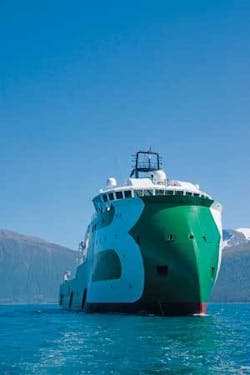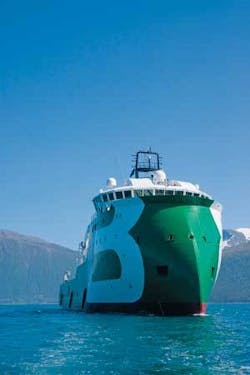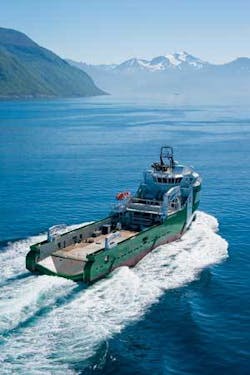Newbuild AHTS safeguards crew against winch/anchor accidents
More flexible propulsion and power management
Nick Terdre - Contributing editor
Bourbon Offshore Norway has taken delivery from the Ulstein group ofBourbon Orca, a new design of anchor-handling tug and supply (AHTS) vessel incorporating three major innovations - Ulstein’s X-bow design, a new safe anchor-handling system, and diesel-electric propulsion. The vessel started its maiden assignment, a short-term charter with Norsk Hydro, in June.
Bourbon Orca is the first vessel to be built to the Ulstein AX104 design. The driving force behind the new design was the desire to provide a much safer platform for anchor-handling. This is one of the more dangerous activities carried out in support of offshore operations, with deck crew manually handling heavy equipment on an exposed deck, often in heavy seas.
The development was triggered some years ago when Statoil urged ship-owners to take on the challenge, and has also been supported by Hydro. “We want to get the crew away from dangerous operations that were previously performed manually,” says senior engineer Øystein Gabrielsen. “These new solutions are a good contribution toward reducing risk to the ship’s crew.”
Step-change in safety
The new solutions he refers to constitute the Safe Anchor Handling System (SAHS) developed by Odim, a supplier of deck handling equipment, Ulstein, and Bourbon. The experience of the owner’s captains and crews helped define the most dangerous situations for which alternative solutions were required.
One feature of the patented SAHS system is a stern roller which can be rotated from vertical to horizontal, according to Dag Johnny Seljeseth, Odim’s project manager for the development. An anchor which is to be landed on the deck is winched up against the stern roller while in a vertical position. The roller then is rotated to horizontal with the anchor laying on it, and the anchor winched on board. The force required to land the anchor, which may weigh 25-30 tons, is much less than that required to haul an anchor up and over a traditional fixed stern roller. The SAHS stern roller can therefore have a smaller dimension - a diameter of 1.8 m compared with 4 m for a typical fixed stern roller.
The system also involves two tugger cranes running on rails along either side of the deck. When preparing to take in an anchor, the cranes are used to drop a lasso over the buoy. The crane driver does this by remote control. Heretofore, the lasso was deployed by two men standing in the stern using rods. In the SAHS system, the cranes are used similarly to deploy the pennant catcher to catch the pennant wire attached to the anchor.
Another feature installed in the stern ramp is a hook through which wire or chain is passed before winching operations begin. This eliminates the risk of the wire or chain lashing across the deck as can happen if it is unsecured. The system also includes spin tools, which are used to secure wire. Even when fitted with swivels, large wires can twist and build a lot of energy which may be released in sudden lashing movements.
Diesel-electric breakthrough
Conventionally anchor-handlers use diesel-mechanical propulsion, as the diesel-electric propulsion solutions available until now have been prohibitively expensive and bulky for AHTS operations.
According to Frode Sollid, senior designer at Ulstein Design, the anchor handler presents very awkward power dimensioning criteria - most of the time it uses almost no power, then for short periods it requires almost full power. With a conventional diesel-electric solution this would mean large electric motors for the main propulsion, along with large frequency converters and large transformers. The cost would be excessive, and the equipment would be too bulky to accommodate in the space available in Ulstein AX104’s low-ceiling propulsion room.
Part of Ulstein Design’s solution is to divide each of the 5MW electric motors which drive the twin stern azimuth propellers into two motors in mechanical tandem. One is a frequency-driven 3MW motor and one a directly-driven 2MW motor. Each motor has a much smaller diameter, which fits easily in the available space. Moreover the frequency converter and transformer for the 3MW motor are significantly smaller and less expensive than for a 5MW motor. An additional benefit is that the high-voltage problem is avoided - instead of the 6.6kV required for a 5MW motor, it is possible to use 690v throughout the system, Sollid says.
A special solution also was required for the 1.8MW retractable azimuthing forward thruster which is required when the vessel is operating at full power in bollard pull mode. Together with the two stern thrusters, the odd number of users gives an asymmetric load, which makes it impossible to get full power out of the power station. However, by means of a specially developed coupling between the transformer and the thruster, power is taken from each side of the switchboard at 900kW, making the load symmetric and giving full power utilization.
Ulstein’s diesel-electric power plant also gives efficient engine usage and fuel consumption when the ship is idling by running only one of the six generating sets which constitute the power station. The genset is run at medium load while the other five are turned off. In the classic diesel-mechanical arrangement, all two or four main diesel engines have to be run at a very low load, which results in more fuel consumption and dirty running of the engines, which consequently require more maintenance.
Another important issue for AHTS vessels is the “zero pitch loss” introduced by large diameter, high-power propellers, Sollid says. Zero pitch loss is the amount of power the engines have to put into the propeller shaft at zero pitch to keep the propeller running at a fixed nominal rpm in the water. For large AHTS vessels, the loss may be as high as 1MW for each main propeller, which naturally affects the fuel consumption for a constant rpm diesel engine/propeller system. The Ulstein AX104 uses frequency converters for its large propellers. This facilitates very low propeller rpm which eliminates the zero pitch loss and gives a significant reduction in fuel consumption in idling and waiting modes, which is how a typical AHTS vessel spends most of its time.
According to Trond Myklebust, president of Bourbon Offshore Norway, Bourbon Orca’s diesel-electric propulsion system is expected to save about $1 million a year in vessel operating costs.
Debut for new bow
Visually the most distinctive feature of the Ulstein AX104 is the Ulstein X-BOW - an inverted bow which leans gently back as it rises out of the water, extending the hull all the way up to the bridge deck. The tall, curved shape resembles that of a number of Viking and pre-Viking vessels which date to 700-1000 AD. However, the function is very different.
The dominant bow form in modern ships, including offshore vessels, is the bulbous bow. The fundamental design appraisal undertaken for the AX104 project also needed to consider the bow form. Although the SAHS brought significant safety improvements on the anchor-handling deck, and the diesel-electric propulsion system provided a flexible and cost-effective power solution, the conventional bulbous bow and flare still subjected the vessel to pitching and slamming in rough seas. When alternatives were examined, calculations for the new form which became the Ulstein X-BOW indicated it would provide a smoother performance in rough seas. The concept was tested in Marintek’s test tank, and the results surpassed expectations.
The Ulstein X-BOW behaves the same way as a surface piercing bulbous bow. However, being taller, it deflects incoming water more smoothly aftwards in rougher seas, compared to conventional hull lines thanks to volume distribution, says Håvard Stave, design manager at Ulstein Design. By this means, the vessel accelerations and relative movements in water are minimized, allowing a reduction in the power needed to drive the ship forward.
The Ulstein X-BOW gives 900 cu m more buoyancy up to the upper deck for Bourbon Orca than a bulbous bow would, assuming all other design parameters are the same, says Stave. As the ship begins to enter a wave, buoyancy builds immediately, giving it a smooth lift. For a ship with a bulbous bow and flare, the equivalent volume build-up starts later, which leads to increased accelerations to do the same job, and results in increased rates and amplitudes of pitching.
The hydrodynamic benefits extend to transiting in rough seas, when the Ulstein X-BOW provides a smoother ride with less speed loss in waves, Stave says. The smoother ride is important not just for the safety of the deck crew when involved in anchor handling operations, but also because it creates a less stressful working environment in general. Large slamming pressures and noises take their toll on the crew, whether on duty or off.
Other bow benefits
Ulstein has orders for three more offshore vessels with the new bow form. Two are Ulstein PX105 platform supply vessels for Bourbon, Bourbon Mistral and Bourbon Monsoon. This new PSV design takes full advantage of another benefit of the ULSTEIN X-BOW, namely that it allows the accommodation to be pushed forward, significantly increasing the space for cargo or operations. Consequently, it is possible to store five pipe-lengths on the deck compared with four on an equivalent vessel with a conventional bow.
The other ship is Island Constructor, an Ulstein SX121 construction vessel for the Norwegian owner Island Offshore. The vessel can be equipped with a derrick to carry out subsea well intervention and other subsea operations. Model tests on this design in the summer indicated, as was expected, that the bow reduces pitching accelerations, which is a significant benefit since there are personnel working in the derrick, Stave says.
For transiting in calm waters, the Ulstein X-BOW provides no particular advantages over the bulbous bow. However, the other benefits, especially the greater cargo area, still apply, and in addition it is no more costly to build the Ulstein X-BOW than a bulbous bow, Stave points out. Ulstein reports that in response to the many enquiries received from ship-owners, it is investigating the applicability of the X-bow to other types of vessel.
Bourbon Orca is part of a major newbuilding program undertaken by the French group, which worldwide has some 90 vessels under construction as part of a €1.45 billion investment program through to 2010.
Despite its involvement in the Bourbon Orca development, Bourbon has claimed no rights to the new solutions. “Naturally we want to be the first on the market with these innovations, but we have nothing against other shipowners choosing the same solutions. Then we’ll have achieved what we wanted - to create a safer workplace for all mariners,” says Myklebust.


